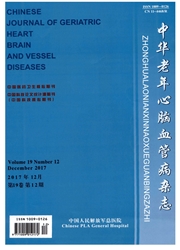

 中文摘要:
中文摘要:
目的观察亚低温联合微创术治疗对脑出血患者血清神经元特异性烯醇化酶(NSE)和内皮素(ET)含量的影响,探讨头部亚低温联合微创术治疗脑出血的机制。方法选择发病24h内的脑出血患者47例,随机分为治疗组(22例)和对照组(25例)。采用电化学发光免疫法检测血清NSE和ET含量,美国国立卫生研究院脑卒中量表(NIHSS)评估两组治疗前后神经功能缺损评分。结果治疗前2组患者血清NSE、ET和NIHSS评分之间差异无统计学意义(P〉0.05)。治疗1周后,与对照组比较,治疗组患者血清NSE和ET含量降低,差异有统计学意义(P〈0.01),治疗组NIHSS评分较对照组改善,差异有统计学意义(P〈0.01)。结论亚低温联合微创术治疗可改善脑出血患者神经功能,其机制之一可能是降低脑出血后血清NSE和ET含量。
 英文摘要:
英文摘要:
Objective To observe the effect of hypothermia and minimally invasive surgery on content of serum neuronal specific enolase(NSE) and endothelin(ET) in patients with cerebral hemorrhage. Methods Forty-seven patients with cerebral hemorrhage(〈24 h) were randomly divided into two groups:an intervention group ( n = 22, treated with hypothermia and minimally invasive surgery for 1 week in addition to the routine medication) and a control group( n = 25, treated with routine medication). The serum levels of NSE and ET were determined by electrochemiluminescence,the scores of neurological dysfunction was evaluated by NIHSS (National Institutes of Health Stroke Scale). The contents of serum NSE and ET and score of NIHSS were assessed before and after intervention respectively. Results Before treatment, there were no significant differences in the contents of serum NSE and ET and the score of NIHSS between the intervention group and the control. However, after 1 week of treatment,the levels of NSE and ET and the score Of NIHSS in the intervention group were significantly lower than those in the control group ( P 〈0.01). The levels of NSE and ET showed a positive correlation with the scores of NIHSS (r = 0. 798, P 〈0.05 ; r = 0. 787, P 〈0.05). Conclusion Hypothermia and minimally invasive surgery effectively protect neuron and promote rehabilitation in patients with cerebral hemorrhage.
 同期刊论文项目
同期刊论文项目
 同项目期刊论文
同项目期刊论文
 Platelet-endothelial cell adhesion molecule-1 gene polymorphism and its soluble level are associated
Platelet-endothelial cell adhesion molecule-1 gene polymorphism and its soluble level are associated 期刊信息
期刊信息
